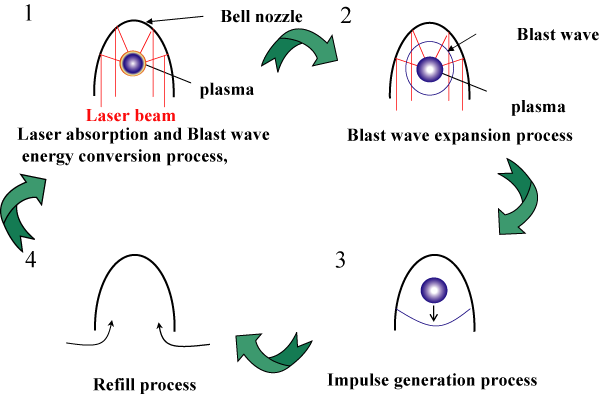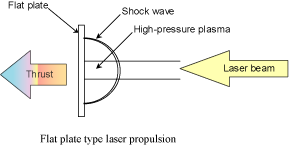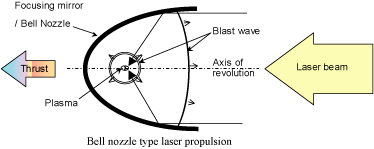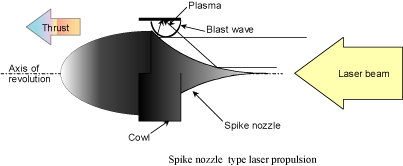RP Laser Propulsion System.
- - What is Laser Propulsion
- - CW Laser Propulsion
- - RP Laser Propulsion
- - The thrust generation mechanism of RP Laser Propulsion
- - Proposed lauching systems
- - History of Laser Propulsion research
What is Laser Propulsion
Laser propulsion is drawing attention as a new outer space launching system that can transport large amounts of payload at low price. Laser propulsion was firstly proposed by professer Kontrovitz in 1972, early after the invention of the laser. After this proposal, the idea of using lasers as an energy source for outer space transportation was furtherly researched in America, Russia, Germany, and Japan. Each country comoetitvely researched laaser propulsion, due to its high potential.
One characteristic of laser propulsion is the fact that thrust can be generated just by shooting a laser beam at the vehicle from a laser facility placed in outer space or on the ground. This makes the structure of the vehicle simple compared to conventinal rockets. As for the air breathing type laser propulsion, air is used as a propellant, and there is no need to carry any oxidizer or fuel onboard, which makes it able to transport payloads efficiently.
Laser propulsion can be divided in to "CW laser propulsion", and "RP laser propulsion" by the way the laser is transported.
CW Laser Propulsion
One form of laser propulsion is CW laser propulsion which uses a Continuous Wave(CW) laser. The laser shot at the vehicle is focused in order to generate plasma, and the electrons within the plasma absorb the laser energy within the vehicle. Whilst the laser is being shot, Laser Sustained Plasma(LSP) is generated within the vehicle. The onboared propelant is heated by passing through the LSP, and generates thrust by being expanded using a nozzle.
RPレーザー推進
The other form of laser propulsion uses an Repetitive Pulse(RP) laser. Explosions of air, or ablation of materials which are caused by the focused pulse laser are used to generate thrust. The pressure rise caused by the blast waves due to these phenomenas generate the thrust. RP laser propulsion is considered to be used in missions that require large thrusts, because it is expected to acheive a higher thrust compared to CW laser propulsion.
Professor Kantrovitz proposed a system in which ablation was used, but nowadays the air breathing type is being researched more due to the fact that it does not require any on board propellant.
The thrust generation mechanism of RP Laser Propulsion
When a pulse laser is focused to a high enough intensity, air discharge occurs, and plasma is generated. This plasma absorbs the laser energy through inverse brehmmmmmmmmmm radiation, and expands at a high speed and compresses the air around it, which drives a blast wave. Thrust is generated from the aerodynamic energy of the blast wave, and the acceleration of the heated air by a nozzle.
The thrust generation process can be divided into 4 steps.
1. Laser absorption and blast wave energy conversion
2. Blast wave expansion
3. Impulse generation
4. Air refill
The image shown below is a overview of the thrust generation process

Proposed lauching systems
Below are the 3 main methods of laser propulsion proposed since 1972
1. Flat plate type laser propulsion

2. Bell nozzle type laser propulsion

3. Spike nozzle tyoe laser propulsion

History of Laser Propulsion research
The table below is a time line of research conducted on laser propulsion
| Year | Event |
| 1957 | Invention of the laser |
| 1972 | Proposal of laser propulsion by Professor Kantrovitz |
| ~1980 | Research of plate type laser propulsion |
| 1998 | Myrabo (America) Demonstration using a 10 kW CO2 laser - Vehicle type: Spike nozzle type - Vehicle mass 100g - Acheived height 4m |
| 2000 | Germany ddddddddddddddd center Demonstration using a 8 kW CO2 laser - Vehicle type: Bell nozzle type - Vehicle mass 53g - Acheived height 60cm |
| 2000 | Myrabo (America) Demonstration using a 10 kW CO2 laser - Vehicle type: Spike nozzle type - Vehicle mass 50g - Acheived height 71m |
